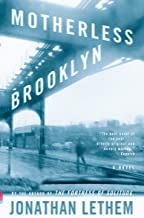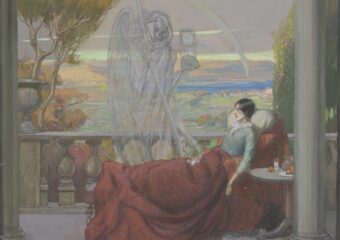Jonathan Lethem
New York
Vintage Comtemporaries
2000
311 pages
According to the Art:
From this novel, we get a view—Lethem’s—of how Tourette syndrome can affect everyday life and how it can progress; how people with the syndrome can think about it; the balance people seek between benefits and side effects of drug therapies; and whether it’s acceptable to think that some verbal and physical tics are funny.
Synopsis:
Lionel Essrog is the narrator and main character of the novel, although when his Tourette syndrome kicks in, he might introduce himself as: “Liable Guesscog, Final Escrow, Ironic Pissclam, and so on,” (p. 7) Tourette syndrome is a neurological condition causing involuntary, repetitive movements and vocal sounds (e.g., words, utterances, growls)—tics.
Lionel lived at the Saint Vincent Orphanage in Brooklyn, New York until a local “penny-ante hood,” Frank Minna, recruited him and three other “white boys” to do his bidding as a “motley gang of high-school-dropout orphans.” (p. 291) Truck piracy was their first line of work, all the while oblivious about why they were moving boxes from one truck to another. Minna expanded his business into more lucrative and dangerous activities under the façade of a limousine service and private detective agency. He gets too close to the sun and is murdered. Lionel liked Minna, who became a father figure to him, accepted his Tourette quirkiness, and even conspired with him to throw their clients off balance when it served their purpose. Though Lionel admitted, “We were as much errand boys as detectives,” he recasts himself as a bona fide detective and makes finding the murderers his raison d’être. (p. 156)
In typical murder-mystery fashion, Lionel must wend his way through complex relationships and find hidden clues to solve the case. In not-so-typical fashion, he contends with the Tourette syndrome accompanying him; Tourette is a major character in the book. Together, they find who murdered Frank Minna.
Analysis:
Jonathan Lethem, in a 2000 interview with The Guardian, credited an Oliver Sacks essay for the idea to make Tourette syndrome the centerpiece of a novel. Tourette syndrome struck him as a view of “that aspect of human existence that is helpless, compulsive, twitchy.” Lethem’s imagination fuels both the story and how Tourette syndrome works within it. As he intersperses Lionel’s days with compulsions and twitches, he intersperses them throughout the book.
The story and characters in the novel make it rewarding for many readers. The prominent role Tourette syndrome plays brings added rewards for readers interested in how literary fiction can expand on medical descriptions of particular illnesses. From this novel, we get a view—Lethem’s—of how Tourette syndrome can affect everyday life and how it can progress; how people with the syndrome can think about it; the balance people seek between benefits and side effects of drug therapies; and whether it’s acceptable to think that some verbal and physical tics are funny. Lethem admits, though, that Lionel is a “hypertrophied, literarily decorated version” of Tourette syndrome.
Throughout the novel we see Lionel’s Tourette syndrome emerge in all sorts of situations, “For me, counting and touching things and repeating words are all the same activity. Tourette’s is just one big lifetime of tag, really.” (p. 5) We see how Tourette syndrome can begin and progress to this point: “By the time I was twelve…I had begun to overflow with reaching, tapping, grabbing and kissing urges—those compulsions emerged first, while language for me was still trapped like a roiling ocean under a calm floe of ice.” (p. 45) But then that “frozen sea” began to melt and his Tourette expanded to encompass verbal tics: “It’s one thing to stroke Leshawn Montrose’s arm, or even to kiss him, another entirely to walk up and call him Shefawn Mongoose, or Lefthand Moonprose, or Fuckyou Roseprawn.” (p. 47) But, in Lethem’s telling, the onset of verbal tics can be a relief in a way as Lionel says they “liberated me from the overflowing disaster of my Tourettic self, turned out to be the tic that satisfied where others didn’t, the scratch that briefly stilled the itch.” (p. 57)
Lionel’s tics attract attention, but Lethem shows how people can get used to his tics and see him more as just quirky. “My outbursts, utterances and tappings were white noise or static, irritating but tolerated, and finally boring unless they happened to provoke a response from some unsavvy adult, a new or substitute teacher.” (p. 83) Minna would say to clients: “Don’t mind him, he can’t help it…He likes to get a little nutty sometimes. Forget about it.” (p. 57) Lethem goes further implying Tourette syndrome does not diminish intellectual capability through Lionel’s work solving Minna’s murder.
From the outward appearances Lethem depicts, he goes inward to explore how people with Tourette syndrome might think of their plight. In one instance, he has Lionel wish to be seen as strange rather than a collection of symptoms.
What might be only strangeness must always be auditioned for relegation to the domain of symptom, just as symptoms push into other domains, demanding the chance to audition for their moment of acuity or relevance, their brief shot—coulda been a contender!—at centrality. Personalityness. There’s a lot of traffic in my head, and it’s two-way.
p. 131
In another instance, Lethem has Lionel go meta in considering how someone with Tourette syndrome might think about how they think about it.
Have you noticed yet that I relate everything to my Tourette’s. Yup, you guessed it, it’s a tic. Counting is a symptom, but counting symptoms is also a symptom, a tic plus ultra. Thinking about ticking, my mind racing thoughts reaching to touch every possible symptom. Touching touching. Counting counting. Thinking thinking. Mentioning Tourette’s. It’s sort of like talking about telephones over the telephone, or mailing letters describing the location of various mailboxes.
p. 192
Lethem broaches Tourette syndrome treatments, but only as a choice between tamping down tic behaviors at the cost of side effects or accepting behaviors and avoiding side effects. Three powerful drug treatments are mentioned: haloperidol, clonazepam, and pimozide. Through Lionel, Lethem wages that accepting available treatments is not always the preferred choice for Tourette syndrome.
The chemicals slowed my brain to a morose crawl, were a boot on my wheel of self. I might outsmart my symptoms, disguise or incorporate them, frame them as eccentricity or vaudeville, but I wouldn’t narcotize them, not if it meant dimming the world (or my brain—same thing) to twilight.
p. 83
Tourette syndrome behaviors are uncomfortable for those who must bear them, attract unwanted attention (e.g., bullying, ridicule), and thwart opportunities. So, can it be funny? Lethem seems to think so. Some of the utterances and physical behaviors he creates and where he places them are laugh-out-loud funny (“Ziggedy zendoodah” Lionel blurts out in the silent Zen temple), but they are not mean, and often received as nothing more than quirky. (p. 201) I could not find public accounts of Tourette syndrome advocates condemning Lethem for disparaging or harming their constituency, and indeed they celebrated the Edward Norton’s 2019 film adaptation.
Also:
This is not the first time the Tourette syndrome community has been in the spotlight. When the pharmaceutical company winning FDA approval for pimozide decided not to market it because there were too few Tourette syndrome patients to make it profitable, the Tourette syndrome community reacted. It marshalled a coalition of legislators and patient advocates to get the Orphan Drug Act of 1984 passed. The law provides pharmaceutical manufacturers incentives to develop and market treatments for rare diseases. Now drug treatments for rare diseases represent a third to a half of all new drug and new indication approvals. The patient advocates who led the efforts for passage of the Orphan Drug Act went on to start the National Organization for Rare Disorders, which continues to support rare disease patient organizations.
Recognition: 1999 National Book Critics Circle Award for Fiction
Adapted into film released in 2019.
A version of this post is here at the NYU Literature, Arts and Medicine Database.



